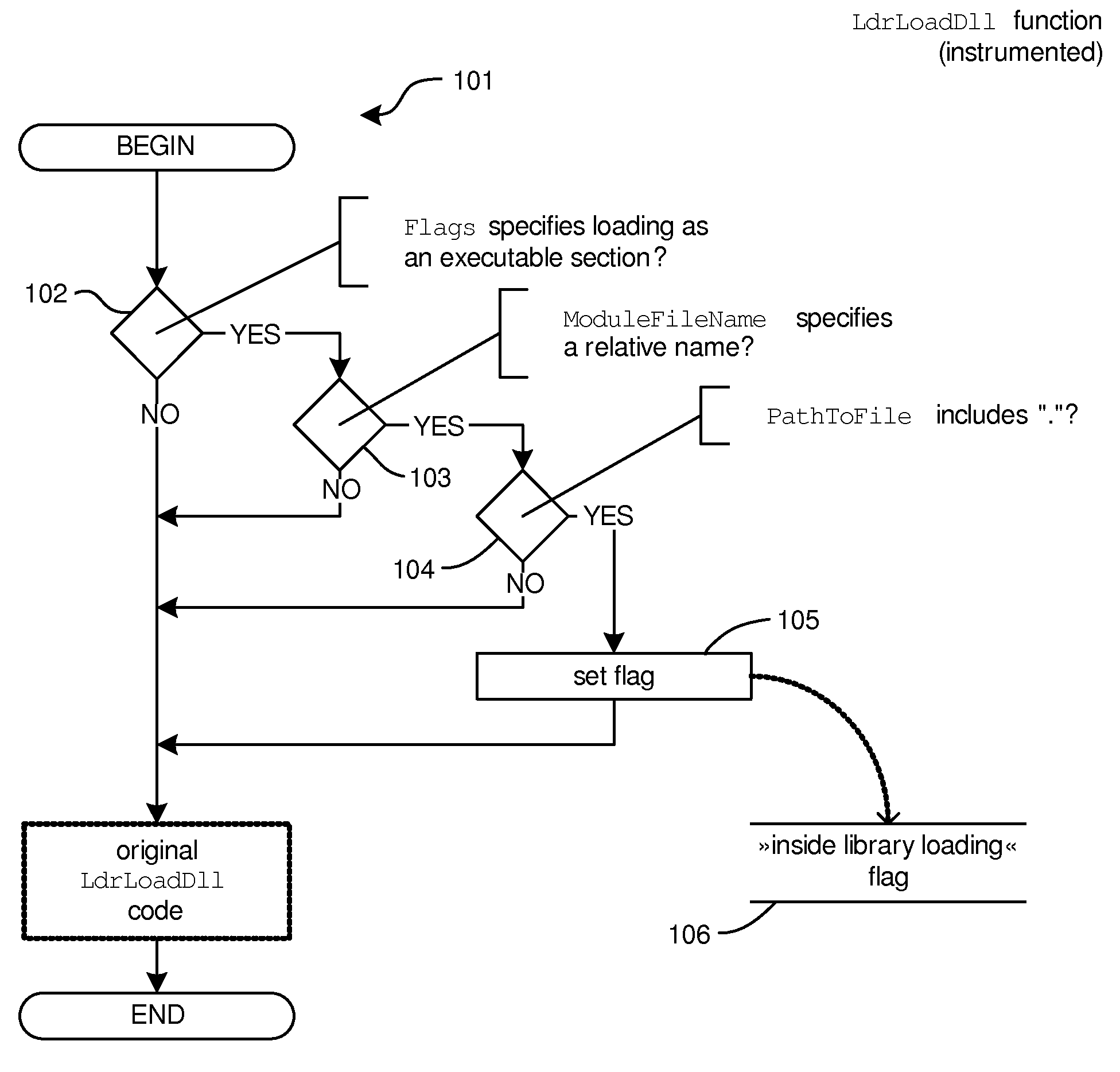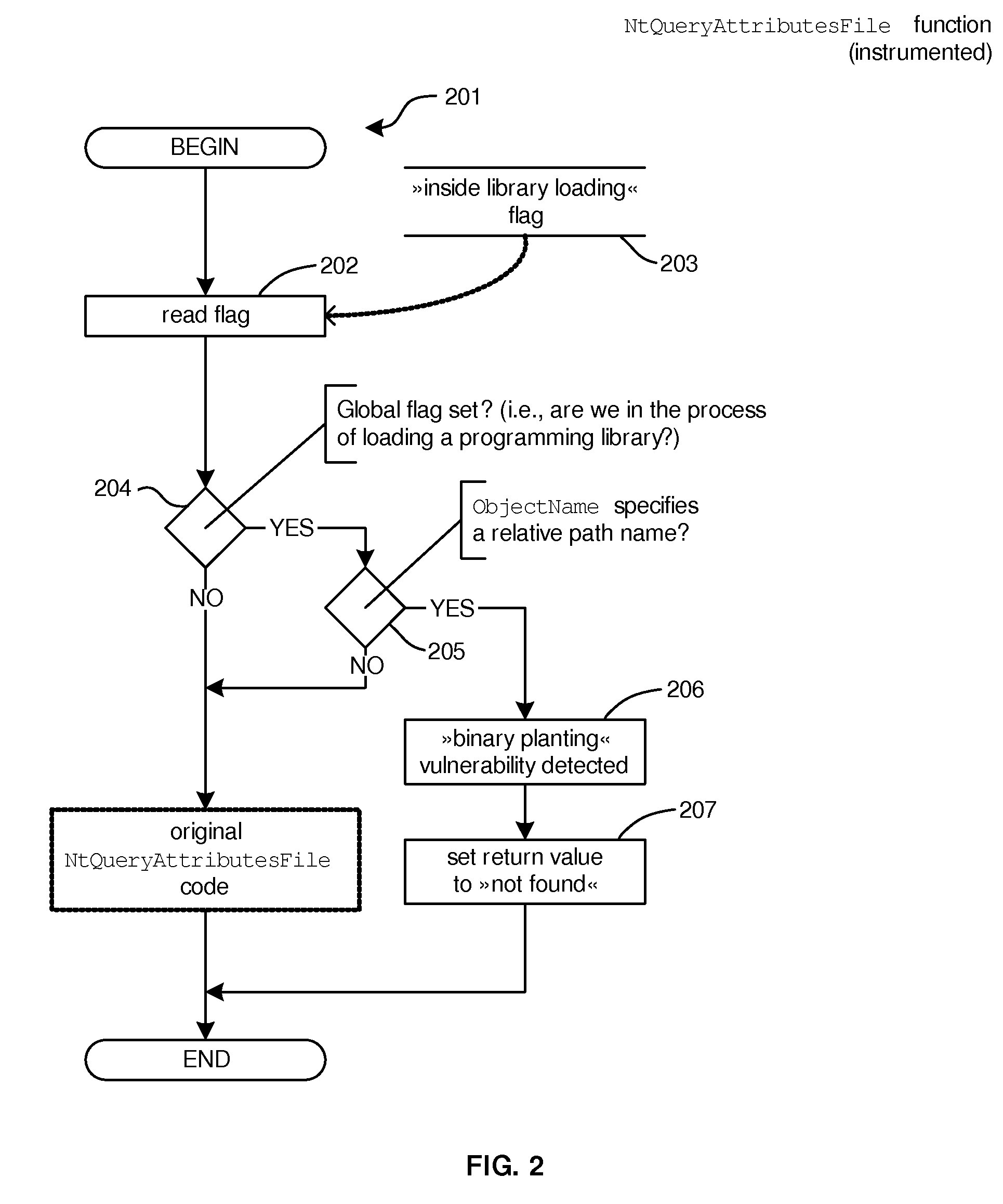Method for detection and prevention of loading executable files from the current working directory
a technology for executable files and working directory, applied in the field of application systems, can solve the problems of different procedures for loading executable files, no widely-known efficient procedure for its detection, and different loading procedures for programming libraries and computer programs, and achieve the effect of preventing the loading or execution of executable files
- Summary
- Abstract
- Description
- Claims
- Application Information
AI Technical Summary
Benefits of technology
Problems solved by technology
Method used
Image
Examples
first embodiment
[0069]In a first embodiment, (Procedure 1), the system is programmed to detect calls to any one or both functions LoadLibraryA, LoadLibraryW. If the path to the programming library (argument lpFileName) is relative, the system checks for the existence of files on the file system upon function entry and determines in advance whether the procedure for finding the library will find it in some location in the search path before trying to find it in the current working directory. If a file with such name is not found in these “priority locations” in the search path, the system concludes that an attempt to load the programming library from the current working directory will take place.
[0070]In a variation of the first embodiment (Procedure 1A), after the system determines that an attempt to load the programming library from the current working directory will take place, the system prevents it by conditionally or unconditionally doing one or more of the following:[0071]modifying the input ...
fourth embodiment
[0087]In a variation of the fourth embodiment, (Procedure 4.1) the system is programmed to detect calls to function NtQueryAttributesFile during the procedure of loading a programming library: upon function entry, the system determines whether a procedure of loading a programming library is underway and whether the file path (member ObjectName of argument ObjectAttributes) is relative. If both conditions are met, it means that an attempt to load the programming library from the current working directory will take place. Determining whether a procedure of loading a programming library is underway is implemented in one of the following ways:[0088]upon detecting calls to some or all functions LoadLibraryA, LoadLibraryW, LoadLibraryExA, LoadLibraryExW or LdrLoadDll the system stores a temporary marker (e.g., in the process's memory, in the registry or on disk) indicating that the procedure of loading a programming library is underway, such that this marker will be accessible from functi...
seventh embodiment
[0109]In the present invention (Procedure 7), the system is programmed to detect calls to some or all functions CreateProcessA, CreateProcessW, CreateProcessAsUserA, CreateProcessAsUserW, CreateProcessWithLogonW, CreateProcessWithTokenW, CreateProcessInternalA, and CreateProcessInternalW. If the specified path to the computer program (argument lpApplicationName) is relative, the system concludes that an attempt to launch a computer program from the current working directory will take place.
[0110]In a variation of the seventh embodiment (Procedure 7.1) the system is programmed to detect calls to one or more of functions CreateProcessA, CreateProcessW, CreateProcessAsUserA, CreateProcessAsUserW, CreateProcessWithLogonW, CreateProcessWithTokenW, CreateProcessInternalA, and CreateProcessInternalW. If the path to the computer program is not specified (argument lpApplicationName is NULL), while the specified command line (argument lpCommandLine) represents a relative path to a computer pr...
PUM
 Login to View More
Login to View More Abstract
Description
Claims
Application Information
 Login to View More
Login to View More - R&D
- Intellectual Property
- Life Sciences
- Materials
- Tech Scout
- Unparalleled Data Quality
- Higher Quality Content
- 60% Fewer Hallucinations
Browse by: Latest US Patents, China's latest patents, Technical Efficacy Thesaurus, Application Domain, Technology Topic, Popular Technical Reports.
© 2025 PatSnap. All rights reserved.Legal|Privacy policy|Modern Slavery Act Transparency Statement|Sitemap|About US| Contact US: help@patsnap.com



